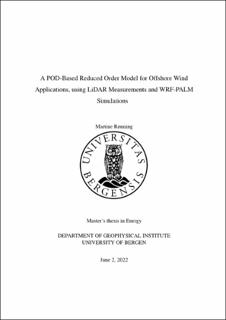| dc.description.abstract | Wind flow fields within a wind farm, including wake dynamics, are a complex system of large degrees of freedom. The wake shape and velocity deficit downstream of a turbine may be calculated using numerical modeling, such as Large Eddy Simulations (LES). However, these estimations are computationally expensive and time-consuming. On the other hand, analytical models may provide efficient computations but generally exclude several features of the wake dynamics. Reducing the complexity of the numerical models and improving the details of the analytical models are highly relevant issues for today’s wind farm controlling and layout designing. This work proposes a methodology applicable to the industry to conduct wind farm flow field calculations by investigating the wake dynamics based on applying Proper Orthogonal Decomposition (POD) to Light Detection And Ranging (LiDAR) measurements and Weather Research and Forecasting (WRF) data using a Parallelized Large Eddy Simulation Model (PALM). Both data sets comprise a complex, high-dimensional system consisting of an area of Germany’s first offshore wind farm, Alpha Ventus, located in the North Sea. 10 days of wind speed and direction data are retrieved from the radial velocity measured by the LiDAR at the FINO1 platform, located in close proximity to the wind farm Alpha Ventus, between September and October 2016, during varying atmospheric forcing conditions. The WRF-PALM data were simulated for one hour on the 21st of September 2015, using ERA5 data as input, during unstable conditions. Reduced Order Models (ROMs) are built separately for both the LiDAR and WRFPALM data, by decomposing them into a number of time-dependent, truncated weighting coefficients and spatial orthogonal basis functions. Proper Orthogonal Decomposition (POD) is shown to reconstruct selected wind fields in a reduced manner while preserving the global patterns of the wind fields for both LiDAR and WRF-LES data. The study has further investigated the ability of the Gaussian Process (GP) to incorporate unresolved small-scale wake structures in the reconstruction that are excluded by the truncated ROM. A sensitivity study for a variety of kernels accompanied by hyperparameters is conducted. By replacing the temporal weighting coefficients obtained for the POD with stochastic weights obtained from the GP, the study has shown that the reconstruction is sensitive to kernel selections. By reconstructing the field using both the weighting coefficients from the standard POD and those obtained using GP, both for the retrieved and WRF-PALM data, the performance of the methods has been evaluated based on visual inspection, energetic contribution, and Root Mean Square Error (RMSE). | |
